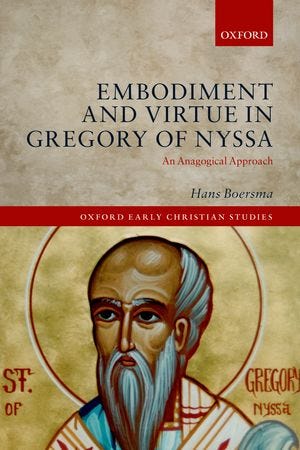Embodiment in the theology of Gregory of Nyssa is a much-debated topic. Hans Boersma argues that this - worldly realities of time and space, which include embodiment, are not the focus of Gregory's theology. Instead, embodiment plays a distinctly subordinate role. The key to his theology, Boersma suggests, is anagogy, going upward in order to participate in the life of God.
This book looks at a variety of topics connected to embodiment in Gregory's thought: time and space; allegory; gender, sexuality, and virginity; death and mourning; slavery, homelessness, and poverty; and the church as the body of Christ. In each instance, Boersma maintains, Gregory values embodiment only inasmuch as it enables us to go upward in the intellectual realm of the heavenly future.
Boersma suggests that for Gregory embodiment and virtue serve the anagogical pursuit of otherworldly realities. Countering recent trends in scholarship that highlight Gregory's appreciation of the goodness of creation, this book argues that Gregory looks at embodiment as a means for human beings to grow in virtue and so to participate in the divine life.
It is true that, as a Christian thinker, Gregory regards the creator-creature distinction as basic. But he also works with the distinction between spirit and matter. And Nyssen is convinced that in the hereafter the categories of time and space will disappear - while the human body will undergo an inconceivable transformation. This book, then, serves as a reminder of the profoundly otherworldly cast of Gregory's theology.
Purchase the book from Oxford University Press.
REVIEWS
Hans Boersma’s Embodiment and Virtue in Gregory of Nyssa: An Anagogical Approach is a compelling and erudite analysis of the significance of bodiliness in one of the most popular Church Fathers to have emerged from theressourcement movement of the 20th century. . . . [T]his study is rich in its exegetical offerings and shows why so much prior scholarship has gone awry by projecting its often unexamined theoretical commitments onto a pre-modern discourse. As a corrective to that body of research, Boersma’s offering is deeply persuasive - a must-read for those researching Gregory of Nyssa.
— Raphael Cadenhead, Reviews in Religion & Theology
[Boersma] has produced a cogent-occasionally exhilarating-monograph.
— Thomas E. Hunt, Journal of Theological Studies
Although the book is aimed at the patristic scholar, fortunately its lucid prose and well structured chapters make it accessible to the non-specialist. Gregory’s anagogical and otherworldly emphasis offers a refreshing challenge to our modern sensibilities, and certainly must be wrestled with by anyone who is interested in embodiment and broad sacramentality. Like everything else that Boersma writes, Embodiment and Virtue in Gregory of Nyssa is worth the read.
— Andrew T. J. Kaethler, Transpositions
Boersma offers many interesting insights, based on an intimate acquaintance with Gregory’s works. ... [I]n doing so he gives us a salutary reminder of the distance between a fourth-century ontological framework and our own.
— Ann Conway-Jones, Journal of Ecclesiastical History
CONTENTS
Introduction
1. Measured Body
2. Textual Body
3. Gendered Body
4. Dead Body
5. Oppressed Body
6. Ecclesial Body
7. Virtuous Body
Epilogue


